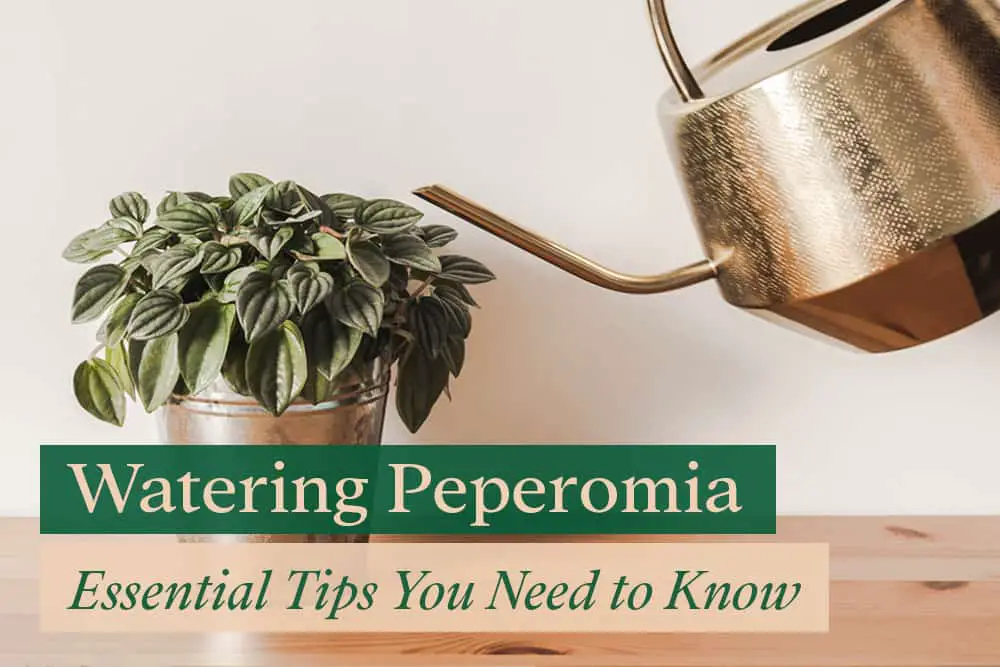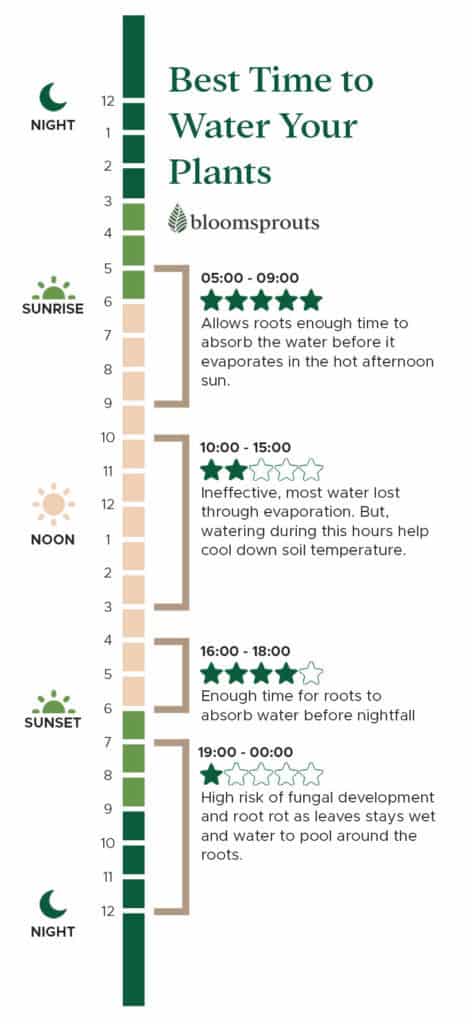
Did you just buy a Watermelon Peperomia or Peperomia Hope? And now you are wondering how often you should water it?
Generally, you should water Peperomia plants once every two weeks. However, the temperature, humidity, and soil mix significantly impact the Peperomia plant’s watering requirements. Make sure the soil has completely dried between watering.
In this article, I’m so excited for you to learn my watering techniques that will help promote plant growth and avoid root rot. You’ll also discover that a variety of factors can influence Peperomia watering frequency.
- How often to water Peperomia plants
- Factors influencing watering frequencies
- Essential tips on watering Peperomia
- Signs of improper watering
So let’s begin
Bloomsprouts may earn an affiliate commission if you purchase something through recommended links.
Also read: Propagating and Growing Peperomia in Water – Is It Possible?
How Often to Water Peperomia Plants?
Peperomias have thicker leaves and stem when compared to other houseplants. These features allow the plant to store more water in the stem and reduce moisture loss in the leaves during transpiration.
As a result, the roots will take longer to absorb water, which allows the soil to stay wet for longer.
In my experience, the soil in Peperomia will dry up completely after two weeks, so they only require watering every other week.
Factors Affecting How Often to Water a Peperomia
While ideally Peperomias should be watered once every other week, many other factors can affect the watering frequency.
Soil Mixtures
Soil acts like a sponge, soaking up and holding on to water. Your Peperomia watering plan will be heavily influenced by the soil’s ability to drain excess water and how much moisture it can retain.
Too much coarse material in the soil mix will cause it to dry out quickly, reducing the amount of water that the soil can retain. As a result, you’ll have to water more frequently.
On the other hand, if your soil mix is too dense and compact, it will reduce drainage and keep your soil wet longer. If you water too soon, you’ll induce overwatering and root rot.
Also read: Soil for Peperomia: How to Choose the Right Potting Mix
Temperature & Humidity
Room temperature and humidity significantly impacted the amount of water used during Photosynthesis and lost through transpiration.
Peperomia needs at least a 50% humidity level. Low relative humidity causes the plant to transpire more rapidly, which causes significant water loss for the plant. As a result, you’ll must do more frequent watering.
When the plant is actively growing in the spring and summer, it uses more water to produce energy through Photosynthesis. In contrast, winter dormancy means that less water is required to keep peperomia alive.
Finally, as the temperature rises, water in the soil evaporates faster. This is why people living in warmer climates will need to adjust their Peperomia watering to once a week instead.
Also read: Complete Guide to Use a Humidifier for Houseplants
Plant size
Water helps transport dissolved sugar and nutrients throughout the plant while also generating turgid pressure to keep it upright.
Hence, the larger your Peperomia plant, the more water it will require to perform these tasks.
Must-Know Tips for Watering Peperomia
Now, let’s discuss some water techniques and tips that will help keep your Peperomia plant healthy.
Simple ways to know when to water your Peperomia
Peperomia water requirements can be affected by a range of variables, but then how do you know when to water the plant?
Here’s all you have to do:
Insert your forefinger 2 inches into the soil and feel if the soil is dry. As you remove your finger, any soil sticking to it indicate moisture. But, if the finger comes out clean, then you need to water immediately.
On the other hand, a soil meter can provide a more accurate technique for measuring the dampness of the soil. A reading of less than 3 means that the plant needs to be watered.
Best time to water Peperomia plant
The best time to water your Peperomia plant is early in the morning between 5 am to 9 am, or in the evening between 4 pm to 6 pm.

The early morning schedule allows the roots enough time to absorb the water before it evaporates in the heat of the day.
As plants don’t photosynthesize at night, watering after 6 pm may cause water to pool around the root zone for longer periods, promoting fungal growth and root rot.
The best type of water for Peperomia
Generally, peperomia plants grow best when they are watered with rainwater or distilled water.
The acidity of rainwater helps release micronutrients, such as zinc, manganese, copper, and iron in the potting soil, which are necessary for plant growth.
Tap water, on the other hand, is not recommended. Tap water can cause chlorine toxicity that accumulates in leaf tissue and results in scorched leaves.
When you cannot collect rainwater and must use tap water, allow the water to sit in the sun for at least 24 hours before using it to evaporate any excess chlorine.
Should you water from the top or bottom water Peperomia
If you are unfamiliar with top and bottom watering, it is exactly what it sounds like.
When watering from the bottom of the pot, you let the water sit in a container and allow it to soak up into a container slowly. Whereas top watering is done from the top with a watering can.
The bottom watering technique strengthens the roots because it encourages them to grow toward the water source. However, top-watering your Peperomia once a month is necessary to remove salt and mineral buildup in the soil.
Problems with Improper Watering
Due to their succulent-like leaves and stems, Peperomia is easy to care for and grow.
The main issue with Peperomia is improper watering, which causes root rot, leaf damage, and poor plant growth.
Two significant problems arise when people don’t properly water their plants:
Underwatering
Is it been a while since you watered your Peperomia plant?
There is a good chance that your plant is dehydrated if you can’t recall the last time you watered it.
Furthermore, several factors such as high temperature and low humidity will increase the rate of moisture loss. It must replenish that water by absorbing it from the soil.
Here are some signs of underwatering in Peperomia:

- Stunted growth
- Droopy stems and leaves
- Yellow, curling leaves
- Dry and crispy leaves
How to fix underwatering in Peperomia:
If your Peperomia plants have entirely dried out, submerge them in a sink or tray of water.
Remove the potted plants and set them in a shaded area out of direct sunlight once the soil has expanded or appears moist.
Allow at least 30 minutes for the excess water to drain through the drainage holes.
If you think the soil is still too dry, go through the process again.
Overwatering
Because I was used to watering most of my houseplant once a week, I did the same with my Peperomia. This, however, resulted in overwatering.
Aside from not allowing the soil to dry between waterings, using an improper soil mix that is too dense and compact will result in waterlogging.
Here are some signs of overwatering in Peperomia:
- Stunted growth.
- Lower leaves turn yellow.
- The plant looks wilted.
- The soil remains wet for more than two weeks.
- Foul odor from the soil.
- Roots are black and mushy.
How to fix overwatered Peperomia
To begin, reduce the frequency of watering Peperomia to once every two weeks or when the soil is entirely dry (whichever comes first).
If the soil took longer to dry out, it’s best to repot in a well-draining soil mix. So, take the entire peperomia out of the pot and inspect the root for rot.
Remove any black and mushy roots and soak them in a solution of 3% hydrogen peroxide for a few minutes to kill any remaining pathogens.
Finally, place the plant in a fresh, clean container and set it in aerated soil with good drainage.
Final Thought
Peperomia is easy to care for and does not require as much watering as most tropical plants such as Monstera and Calathea.
Watering once every other week is sufficient to ensure that your Peperomia thrives, as long as they are kept at room temperature, high humidity levels and are given an aerated and well-draining soil.
